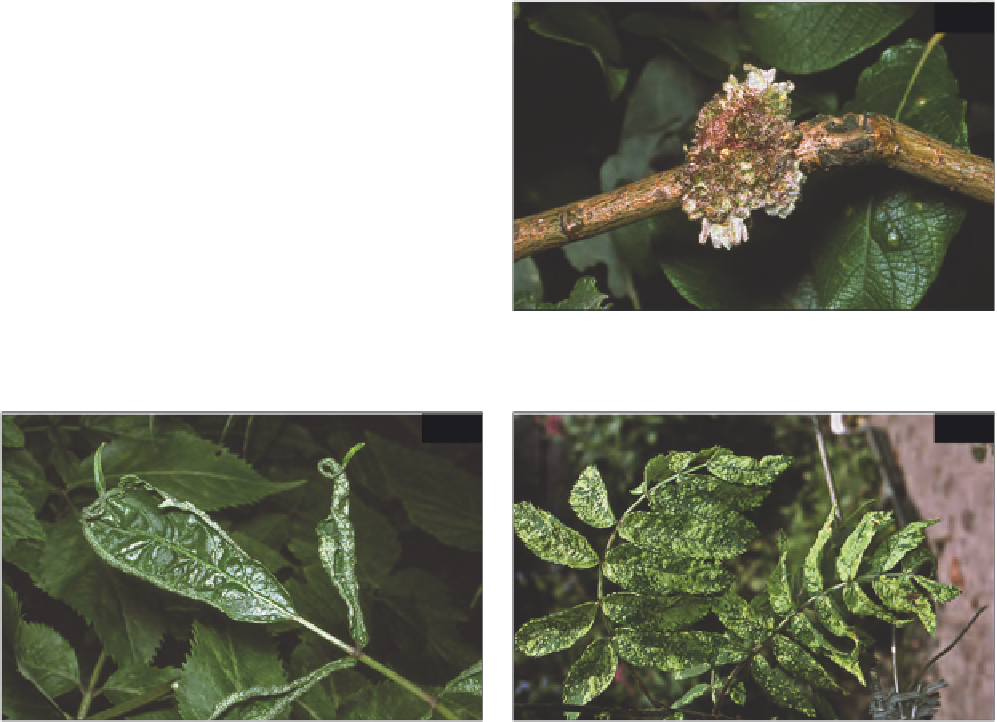Biology Reference
In-Depth Information
Eriophyes triradiatus
(Nalepa) (
1111
)
Willow witches' broom gall mite
This widely distributed and generally common species
occurs in witches' broom galls on various kinds of
willow (
Salix
), including weeping willow (
S. vitellina
var.
pendula
). Although usually abundant in the galls,
and breeding within them throughout the summer, the
mites are not involved in their initiation or development.
Adult females are
c
. 0.17 mm long, with about
80 abdominal tergites and sternites, and a pair of
upwardly directed setae on the prodorsal shield.
tiny aperture on its lower surface. Mites breed within
these chambers throughout the summer. Colony
development ends in the autumn, following the
production of overwintering forms. The galls, which
appear as pale blisters and gradually darken as they
mature, are often common on rowan (
Sorbus
aucuparia
), whitebeam (
S. aria
) and wild service tree
(
S. torminalis
); galling also occurs on crab-apple
(
Malus
), hawthorn (
Crataegus
) and ornamental pear
(
Pyrus calleryana
'Chanticleer'). The pest is usually of
minor importance, but heavy attacks on young
ornamentals are troublesome. On certain hosts the mites
are afforded subspecific status: e.g.
Eriophyes pyri sorbi
on rowan;
E. pyri arianus
on whitebeam;
E. pyri
torminalis
on wild service tree. The mites on hawthorn
are often cited as
E. pyri crataegi
or treated as a distinct
species (namely,
E. crataegi
), and those on
Sorbus
are
sometimes collectively described as
E. sorbi
.
SAMBUCUS
Epitrimerus trilobus
(Nalepa) (
1112
)
Elder leaf mite
Widely distributed in association with elder
(
Sambucus
), causing considerable distortion and
discoloration of affected foliage. Infestations often
occur on ornamental bushes, including nursery stock,
but are most common on wild hosts.
SORBUS
1111
Aculus aucuparia
Liro
A free-living species on rowan (
Sorbus aucuparia
). The
mites cause distinct bronzing of the foliage, and
infestations are sometimes noted on nursery stock.
Eriophyes pyri
(Pagenstecher) (
1113
)
Pear leaf blister mite
Although most important as a pest of pear fruit trees,
this species (or species complex) is also associated with
other rosaceous hosts, including ornamentals. The
elongate (
c
. 0.22 mm long), brownish mites overwinter
under bud scales. They become active in the early
spring. Small, light green to yellowish, blister-like galls
are then formed on the unfurling foliage, each with a
1111
Young gall of willow witches' broom gall mite (
Eriophyes
triradiatus
) on
Salix
.
1112
1113
1112
Elder leaf mite (
Epitrimerus trilobus
) damage to leaves
of
Sambucus
.
1113
Pear leaf blister mite (
Eriophyes pyri
) damage to leaves
of
Sorbus aucuparia
.

Search WWH ::

Custom Search